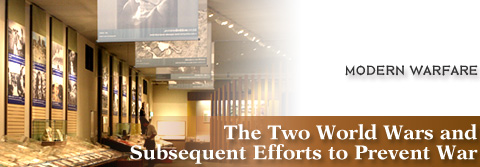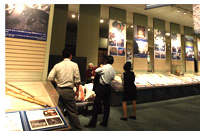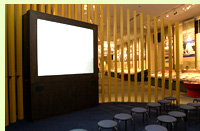| |


|
|
 |
 |
In the twentieth century, humanity experienced two world wars. They were to a large extent conflicts which arose as the great industrial powers of the period continued to expand the territory under their control. World War I was
an all-out battle of nations supported not only by soldiers on the battlefield but also by civilians mobilized to support
their country’s war effort and even by people in the belligerents’ colonies. By World War II, military technology
had developed enough so that bombs could be dropped on cities from aircraft, thus inflicting casualties on noncombatants
as well.
 The horrifying cruelty of these wars is symbolized in this section of the museum by the ceramic reproduction of Picasso’s anti-war painting "Guernica", as well as reminders of the concentration camps at Auschwitz: a piece of the barbed wire used for fences around the camps, a clump of spoons and other utensils that remained after the
Nazis had burned a warehouse at Auschwitz in 1945, and the shoe of a child who was killed at Auschwitz. The horrifying cruelty of these wars is symbolized in this section of the museum by the ceramic reproduction of Picasso’s anti-war painting "Guernica", as well as reminders of the concentration camps at Auschwitz: a piece of the barbed wire used for fences around the camps, a clump of spoons and other utensils that remained after the
Nazis had burned a warehouse at Auschwitz in 1945, and the shoe of a child who was killed at Auschwitz.
|
 |
It is not true that "all is fair in war". The movement to restrict the brutality of war bore fruit in such international agreements as the Hague Rules for Land Warfare (1907) and the Geneva Convention on the Treatment of Prisoners of War (1929), which outlawed the use of toxic substances and the abuse of prisoners of war, respectively. Infractions of these rules are now considered war crimes which can be judged by national courts or international tribunals. After World War II, the concept of what constitutes a war crime was expanded to include crimes against humanity, genocide and breaches of the peace—in other words, the act of starting a war came to be viewed as a crime against peace.
|
| |

The cartoons show how industrialized countries greedily colonized
less developed countries in the 19th Century (far right), and then depict the
conflicts and movements that eventually led to the independence of these colonies
(far left).
|
|
|
| |
 Mini
Theater : "War and Peace in the 20th Century" Mini
Theater : "War and Peace in the 20th Century" |
The curtained Mini Theater in the Museum's basement
exhibit offers a 7-minute video presentation in Japanese on different types of
violence and ways people are trying to solve them. It first discusses physical
violence, focusing on the Cold War, post Cold-War conflicts and weapons development.
It points out that the number of people opposed to war is increasing, and that
there were large-scale protests worldwide before the start of the Iraq War. It
then moves on to explain "structural violence" such as poverty, discrimination
and other human rights violations which prevent the full flowering of human potential.
The third section deals with "cultural violence", including violent video games
as well as restrictive gender roles and stereotyping such as the Japanese penchant
to stereotype people according to their blood type. Finally, it offers ideas
for ways to  solve these problems, including a wide variety of UN activities,
the Kyoto Protocol, the Hague Appeal for Peace, and many NGO activities. It ends
by stressing the need for people to learn about the situation in the world today
and then ask themselves what they can do about it. solve these problems, including a wide variety of UN activities,
the Kyoto Protocol, the Hague Appeal for Peace, and many NGO activities. It ends
by stressing the need for people to learn about the situation in the world today
and then ask themselves what they can do about it.
|
|
|
| |
 Japan's
Constitution Japan's
Constitution |
After World War II ended, the nations of the world came together to establish the United Nations and stipulated in Article 2, Section 4, of the UN Charter that all members must "refrainノ from the threat or use of force."Today, the constitutions of many countries around the world explicitly renounce wars of aggression against other nations. This trend in international law is also reflected in Japan's constitution-Article 9 renounces war as an instrument for settling international disputes.
|
|
|
| |
|
|
|
 |
|
|
|